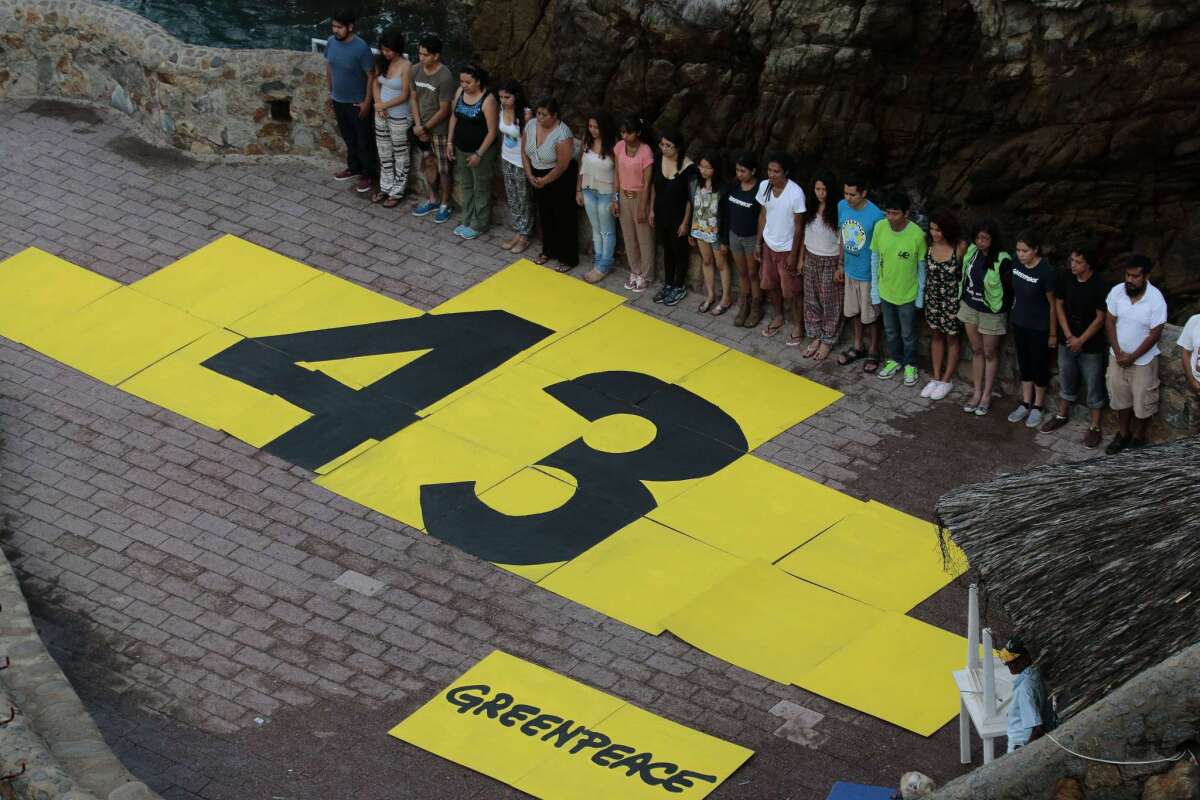New probe: Mexican government was wrong about what happened to 43 missing students

Greenpeace activists demonstrate Sept. 6 in Acapulco, Mexico, to draw attention to disappearance of 43 Mexican students last year.
- Share via
Reporting from Mexico City — The Mexican government’s claim that 43 missing students were killed and burned in a local trash dump in the state of Guerrero nearly a year ago has been discredited by a six-month investigation from an international working group.
The inquiry, published Sunday, also found that the police who allegedly attacked and abducted the students last Sept. 26 could have been acting directly under the orders of drug traffickers to reclaim a cargo of illegal heroin stashed in at least one of the buses in which the students were traveling at the time the attacks occurred.
The kidnapping, disappearance and presumed deaths of the students in the city of Iguala has been one of the biggest scandals to rock the administration of President Enrique Peña Nieto since he took power three years ago.
See the most-read stories this hour >>
Peña Nieto acknowledged the report Sunday afternoon, saying that the government’s investigation into the tragedy should “take into account the elements featured in the working group report.”
Although both the students’ families and other Mexicans have long raised questions about the investigation into the mass disappearance, the report from the international working group represents the first detailed presentation of facts and testimonies that contradict the official version of events.
A number of hypotheses have been floated for why the students were attacked that night, but a motive has never been established.
The report, carried out by an interdisciplinary working group created by the Inter-American Commission on Human Rights, says there is no physical evidence that a fire sufficient to reduce 43 bodies “to ashes” took place on the night of the disappearance. Officials have claimed the bodies were incinerated in a trash dump in the small town of Cocula, which is about a 15-minute drive from Iguala.
The report describes a direct connection between Iguala and the supply of illegal heroin to Chicago. It cites evidence presented in a recent case in Illinois that shows the Guerreros Unidos drug cartel used public transport buses in Mexico to move heroin north from Iguala. The mountains around Iguala are dotted with clandestine poppy fields as well as illicit graves, and Guerrero state is one of the biggest producers of illegal heroin for sale in the United States.
“The [heroin] business that moves through the city of Iguala could explain the extreme violence and massive nature of the attack ... due to the existence of a bus that had been taken by the students but not detained. Until now this line of investigation hasn’t been explored,” the report said.
“In the act of taking the buses, the students -- who intended to use them for transport to a national march on October 2nd -- could have coincided with the existence of illicit drugs (or money) in the buses,” it added.
NEWSLETTER: Get the day’s top headlines from Times Editor Davan Maharaj >>
The inquiry also raises the possibility that the government investigation into what has become known as the “Ayotzinapa” case could have omitted important facts. Five buses were commandeered that night by the students -- a practice common among youth groups lacking resources as a way to get to events -- yet only four are mentioned in the government investigation, according to the working group.
The investigation also concluded that the Mexican military was present during the incidents of that night -- something the government has always denied.
The students who disappeared all studied at a rural teachers college in the small town of Ayotzinapa, about an hour’s drive from Iguala. Some of them and other civilian bystanders were killed when the police opened fire indiscriminately at various locations across the city. Then 43 students were allegedly dragged away and stuffed into police pickups; they haven’t been seen since.
Their disappearance has prompted civilian search parties to scour the hills around Iguala for them and hundreds of other missing people. To date, more than 120 bodies have been found in clandestine graves and handed into the authorities for identification, but none apparently are those of the students.
Bonello is a special correspondent.
ALSO:
U.S. judge dismisses challenge of Arizona’s SB 1070 immigration law
An unabashed left-winger is surprisingly on the rise in British politics
As migrants pour into Germany, Pope Francis calls on faithful to take them in
More to Read
Sign up for Essential California
The most important California stories and recommendations in your inbox every morning.
You may occasionally receive promotional content from the Los Angeles Times.








